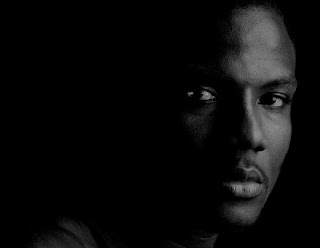Crane shot
Is a shot taken from a crane, a device resembling the "Cherrypickers" used by the telephone company to repair lines.
 A 'Cherrypicker' using a camera to produce the crane shot and job shot effectively
A 'Cherrypicker' using a camera to produce the crane shot and job shot effectively
This shows partly what a crane/jib shot do
The most known uses are to view the actors from above or to move up and away from them (a common way of ending an scene with people meeting up).
Tracking shot,Dolly shot,Trucking shot,crab shot
It is generally any shot in which the camera moves from one point to
another either sideways, in , or out. The camera can be mounted on a set
of wheels that move on tracks or on a rubber-tired dolly, or it can be
hand-held.
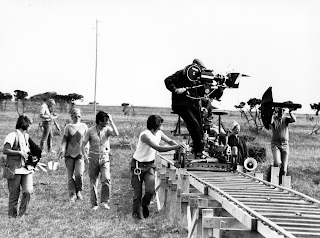
 what is used for dolly/tracking/trucking shot/crab shot how it works
camera operator moves along side
the action. This shot adds excitement
and helps the audience see what
happens as it travels next to the
actors.
what is used for dolly/tracking/trucking shot/crab shot how it works
camera operator moves along side
the action. This shot adds excitement
and helps the audience see what
happens as it travels next to the
actors.
Track -moving the camera forwards or backwards using the dolly
For track/dolly/trucking shot, professionals often use tracks to ensure
smooth and straight movements if using the dolly, mark the floor with
masking tape and have at least one other person to move the camera. you
can also use a pram or any other device with wheels. provided that you
make a solid base for your camera.
For a tracking shot it gives a insight of the area in a sideways view, and in that 'area' there could be people, vehicle's and surroundings.
Pan and panning shot
Short for panorama, this is a revolving horizontal movement of a camera from left to right or Permit.
 showing an example of a camera moving left to right using the pan
showing an example of a camera moving left to right using the pan
Pan turning the camera to the left or right whilst mounted on a tripod.
Showing an example of what a pan does, were it rotates the surrounding area or character,
A pan is an easier way of showing the character get to area 'A and B' without using multiple camera shots. also helps keep the action movements of a subject concentrated in that one scene as it is being moved around or followed.
swish pan, flash pan, zip pan
A horizontal movement of the camera at such a rapid rate that the subject photographed blurs on the screen
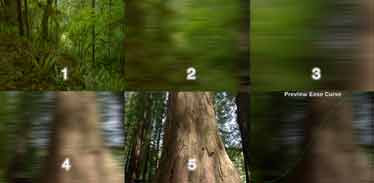
What a swish pan does which is basically moving from one end to another fast.

Flash pan(like a swish pan but with the effect of lights
An example of what the zip pan does.
Zip pan on top(camera gets closer as it performs its swish pan).
Similar to a normal pan, these pans work as an effect to automatically move from a scene A and B but faster, and helps to move a storyline faster, a zip pan(in this shit shown on top) however gives a focus on a person or object, with different distant camera shots.
From one subject to another a zip
pan occurs very quickly and is used to emphasize the second subject. I would like to think it would be used in areas such as documentary or reality shows.
Steadicam
The
invention of cameraman Garrett brown this is a system that excesses
hand-held filming with an image steadiness comparable to the tracking
shot. A assign redistributes the weight of the camera to the hips of the
cameraman; a video monitor frees the cameraman from the eyepiece. it
was first used by Haskell Wexler on 'bound for glory' done on 1975.

The architecture of a steady cam
the Steadicam helps the camera look professionally balanced when creating a scene so viewers can just focus on the images in the film created instead of the shaky camera.
Tilt
Tilting the camera up and down while on a tripod.



Tilt could be used to get a view of a the areas or people from a high ground, low ground and sideways(to show the mass amount of subjects on areas).
Zoom
Using the zoom lens(enlarges subject on screen).
 how Zooming is done
how Zooming is done
Zooming focuses on the subject mater that is displayed on screen and enlarges that subject
so when it is shown in screen, you get the feeling of importance of that particular subject.
Editing
The process by which shots are put together into sequences or scenes. usually described according according to rhythm or pace.
THE PRINCIPLES OF EDITING
To us humans, we see one shot that is followed by another; it is within our nature to relate the shots and the events happening within in either time, space, or both. This is where Editing Theory happens. But in order to understand its theory, you need to be known of the major hallmarks of editing's history. The first years of film/TV series, editing wasn't used as it is today. When film first came about, people mostly used films to make short films. For example, ‘a ship is pulling into the harbour or a train passing by’. These films/TV series didn’t have much of a story. However, it wasn't long before films made by the Lumiere Brothers, and the Edison Company, contained a plot. These filmmakers would set up a camera, and plainly have a short story take place in front of the lens. They didn't move the camera at all, or take shots from different angles. The idea of editing was out the picture as well.
THE PURPOSE OF EDITING
At the most major level, editing form determines meaning in a film in the same way that the rhyme form helps determine meaning in a poem. In most Hollywood films/TV series, editing helps determine at least four dimensions of film narrative: in what order you receive information about the plot, how much information you are supposed to receive about the story, how you are supposed to feel about events and characters at any given time, and how you are supposed to experience the pace of the story. In total, as the idea of montage suggests, editing can serve a brain function, often making visual, political, or idea assertions about the activities you are seeing, as well as emotional appeals. This latter activity tends to belong more to the world of advanced and experimental films.
HOW EDITING HAS CHANGED OVER TIME
Before the widespread use of non-linear editing systems, editing of all films was done with a positive copy of the film, it’s called a film work print. Were it was developed in the 1890s by France Britain and USA.
They did this by physically cutting and pasting together pieces of film, they did this on a machine with a viewer called a Moviola or Steenbeck rollers. Today most films are edited digitally and avoid the film positive work print altogether. In the past, the use of a film positive film allowed the editor to do as much experimenting as the filmer wished, without the risk of damaging the original. And this was the process they went through at that period.
 How editing is being done through print
How editing is being done through print
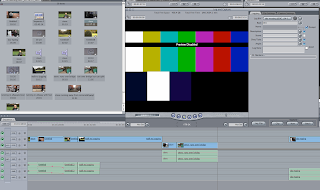 How editing is done through software(this is an example through final cut pro).
How editing is done through software(this is an example through final cut pro).
Editing is usually used to keep film/TV as exciting as possible, so the viewer isn't bored with just one scene.
Montage
 An example what you could do with a montage
https://www.youtube.com/watch?v=x7QhUL8NUK4&list=PLE2A4A347E96A308B&index=2
An example what you could do with a montage
https://www.youtube.com/watch?v=x7QhUL8NUK4&list=PLE2A4A347E96A308B&index=2
(for the PlayStation 4 reveal)
Montage is a technique in film editing in which a series of short shots are edited into a sequence or put together into a sequence. it is mainly used to show the audiences the best bits of something and combine them as a whole.from the 1930s to the 1950s, montage sequences often combined numerous shorts with special optical effects such as 'fades,dissolves,split screens,double and triple exposures', dance and music.they were usually assembled by someone other than the director or the editor of the movie.
Continuity editing/realist editing
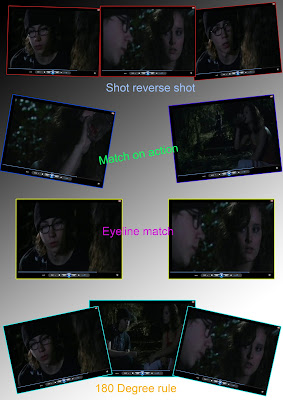 Example of continuity editing
The purpose of continuity editing is to smooth over the inherent discontinuity of the editing process and to establish a logical coherence between shots, and maintains continuous in scenes(people,objects,places etc).
Fast Cutting Editing
Example of continuity editing
The purpose of continuity editing is to smooth over the inherent discontinuity of the editing process and to establish a logical coherence between shots, and maintains continuous in scenes(people,objects,places etc).
Fast Cutting Editing

http://www.youtube.com/watch?v=aRM1nRLCOLs
Fast cutting is a film editing technique which refers to several consecutive shots of a brief duration of 3 seconds or less. It can be used to convey a lot of information very quickly, or to imply either energy or chaos in a scenes.
this is commonly used in trailers and action scenes
Cross-cutting
 http://www.youtube.com/watch?v=5wbjylCEJLw
An example of cross cutting in the TV series 'fringe'.
Cross-cutting is an editing technique to establish action occurring at the same time in two different locations.
so for example a range people are doing something in different locations at the same time both which show talking scenes of 2 people discussing at one and another and the camera cuts to both of them 1, but it help shows how they are all doing this in the time period.
Transition
http://www.youtube.com/watch?v=5wbjylCEJLw
An example of cross cutting in the TV series 'fringe'.
Cross-cutting is an editing technique to establish action occurring at the same time in two different locations.
so for example a range people are doing something in different locations at the same time both which show talking scenes of 2 people discussing at one and another and the camera cuts to both of them 1, but it help shows how they are all doing this in the time period.
Transition
Film transition is a technique used in the post production process of film editing and video editing by which scenes or shots are combined. Most commonly this is through a normal cut to the next scene. Most films will also include selective use of other transitions, usually to convey a tone or mood, suggest the passage of time, or separate parts of the story.
Dissolve/lap dissolve and Fade

 An example of what a lap dissolve and fade does.
A dissolve is a gradual transition from one image to another,The terms fade-out and fade-in are used to describe a transition to and from a blank image. This is in contrast to a cut where there is no such transition. A dissolve overlaps two shots for the duration of the effect, usually at the end of one scene and the beginning of the next scene. this could also help tell the passing of time when there are characters in a scene.
Wipe
An example of one on top
A 'wipe' is a type of film transitions where one shot replaces another by travelling from one side of the frame to another or with a special shape, this is used for inviting the cast, title and credits of anything media related.
An example of what a lap dissolve and fade does.
A dissolve is a gradual transition from one image to another,The terms fade-out and fade-in are used to describe a transition to and from a blank image. This is in contrast to a cut where there is no such transition. A dissolve overlaps two shots for the duration of the effect, usually at the end of one scene and the beginning of the next scene. this could also help tell the passing of time when there are characters in a scene.
Wipe
An example of one on top
A 'wipe' is a type of film transitions where one shot replaces another by travelling from one side of the frame to another or with a special shape, this is used for inviting the cast, title and credits of anything media related.
Flashback
Flashback is an interjected scene that takes the narrative back in time from the current point the story has reached.Flashbacks are often used to recount events that happened before the story’s primary sequence of events, or to fill in back-stories. for the characters in the flashback it tells of there 'Past' lifetime or life.
Jump-cut
A jump cut is a cut in film editing in which two sequential shots of the same subject are taken from camera positions that vary only slightly. This type of edit gives the effect of jumping forwards in time.
jump cuts are considered a violation of classical continuity editing, which aims to give the appearance of continuous time and space in the story-world by DE-emphasizing editing like in this scene of someone driving a vehicle.
Slow-motion
 http://www.youtube.com/watch?v=71nURVXXeaM ( example of slow motion)
http://www.youtube.com/watch?v=71nURVXXeaM ( example of slow motion)
An example of 'slow motion', It is an effect in film-making whereby time appears to be slowed down by half its speed. typically this is achieved when each film frame is captured at a rate much faster than it will be played back. when replaying at normal speed, time appears to be moving more slowly. the technical term for slow motion is 'over cranking' which refers to the concept of cranking a 'hand cranked' camera at a faster rate than normal.
Fast-motion time lapse
Time-lapse is a technique whereby the frequency at which film frames are captured is lower than that used to view the sequence. When played at normal speed, time appears to be moving faster and thus lapsing. For example, a scene may be captured once every second, then played back at 30 frames per second. The result is an apparent 30-times speed increase in a scene.in terms of showing a scene. This also shows an example of how time can be gone quicker in TV scenes to suggest that a 'day' has passed.
biography
http://beatricethrillerblog.blogspot.co.uk/2010/11/camera-angles-and-shots.html
http://en.wikipedia.org/wiki/Film_transition
http://www.blogger.com/blogger.g?blogID=729663911895840176#editor/target=post;postID=7385839243253534841;onPublishedMenu=overview;onClosedMenu=overview;postNum=12;src=postname
www.youtube.com
http://financial-dictionary.thefreedictionary.com/Zip+Pans






